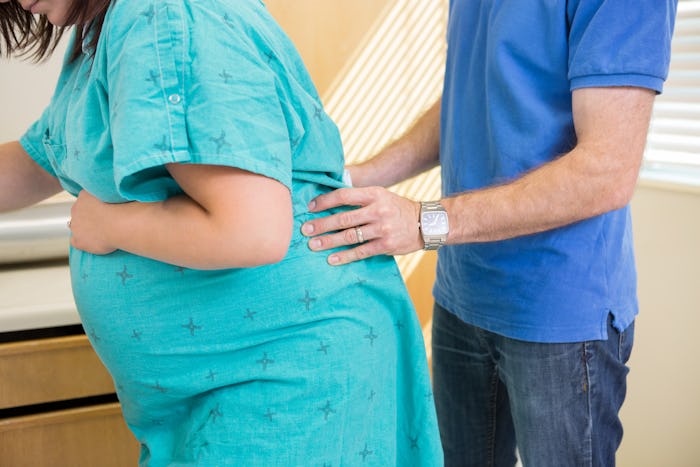Life

Everything You Need To Know About Using Acupressure To Induce Labor
When you're at the end of your pregnancy, the hours can feel like days. You'd do just about anything to get that baby out, and you might find yourself searching for home remedies to induce labor. There's talk that eating certain foods and taking long walks could help induce labor, but what about acupressure? Many women swear that focusing on certain pressure points has induced or even helped to speed up their labors, but does acupressure really induce labor? If you're not a fan of needles, which are used in acupressure's medicinal sister, acupuncture, it may sound like the perfect way to get things moving.
According to a literature review in the Journal of Midwifery and Women's Health, there is not a sufficient amount of studies about acupuncture and acupressure and their effects on labor at this time, and there is need for further research. Specifically, science doesn't yet know much about the efficacy, optimal point selection, best techniques, and length of time for point stimulation of acupressure and its induction of labor.
But, if you do believe in these methods, or you're at your wit's end and you'll try just about anything, you can talk to your doctor about trying them. Then, you should find someone who can show you how to access the relevant pressure points safely (that might be hard to do, as certified practitioners can be rare). One good first step is checking to see if you can find any professionals nearby through the National Certification Commission for Acupuncture and Oriental Medicine.
According to the University of Wisconsin's School of Medicine and Public Health, acupressure can be safely started at 37 weeks, though that date is debated. Acupressure at some pressure points may help start contractions, but before starting, discuss with your clinician to help determine if acupressure is right for you.
Kristen Burris, Licensed Acupuncturist (L.Ac.), Master of Science in Traditional Oriental Medicine, and Master Herbalist of Eagle Acupuncture, tells Romper, "Acupuncture has been proven to be effective to aid the start of labor, and by extension, many hope that acupressure can be just as helpful." But, there's a few things to check on before you attempt acupressure to induce labor.
You actually want to make sure that you are at least 38 weeks pregnant, Burris says, and that the baby is in position with its head down. You also want to make sure you can tolerate a bit of pain. "While acupuncture tends to be painless depending on practitioner skill level and needle quality, acupressure, when done properly, is quite strong and can feel painful, especially to women who are sensitive or have fibromyalgia," she says.
"When you are able, seek out the help of a licensed, professional acupuncturist and apply acupressure as an adjunct therapy to their treatments," Burris continues. Attempting to find pressure points to apply pressure with your fingers or instruments can be a challenge for those untrained. Finding a skilled practitioner is best if you want to explore acupressure options, and there are also videos online that can help you to find the exact locations you are trying to stimulate.
Finding a comfortable position while attempting acupressure is key, as it can be easy to tire while applying pressure, too. "Try a reclining chair," Burris suggests, "and if your partner's hand or your fingers tire, try using the bottom of a wooden spoon or a bottle top as your acupressure tool."
The bottom line is that acupressure may or may not work to help induce your labor, but as long as you're cleared and not in pain, it's one of those things that may make you feel better to try. Sometimes, feeling like you're doing something to help is better than just waiting, right? Just remember to talk to your doctor before attempting to induce labor by any method, regardless of how much that sweet babe is pressing on your bladder.
Check out Romper's new video series, Romper's Doula Diaries:
Check out the entire Romper's Doula Diaries series and other videos on Facebook and the Bustle app across Apple TV, Roku, and Amazon Fire TV.